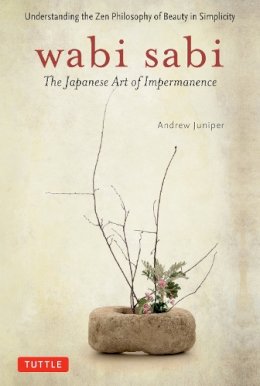22%OFF

Stock image for illustration purposes only - book cover, edition or condition may vary.
Wabi Sabi: The Japanese Art of Impermanence
Andrew Juniper
€ 14.99
€ 11.65
FREE Delivery in Ireland
Description for Wabi Sabi: The Japanese Art of Impermanence
Paperback. Num Pages: 176 pages, b&w. BIC Classification: 1FPJ; ACN; AK. Category: (G) General (US: Trade). Dimension: 228 x 157 x 12. Weight in Grams: 258.
Developed out of the aesthetic philosophy of cha-no-yu (the tea ceremony) in fifteenth-century Japan, wabi sabi is an aesthetic that finds beauty in things imperfect, impermanent, and incomplete.
Taken from the Japanese words wabi, which translates to less is more, and sabi, which means attentive melancholy, wabi sabi refers to an awareness of the transient nature of earthly things and a corresponding pleasure in the things that bear the mark of this impermanence. As much a state of mind—an awareness of the things around us and an acceptance of our surroundings—as it is a design style, wabi sabi begs us to appreciate the pure beauty of life—a chipped vase, a quiet rainy day, the impermanence of all things. Presenting itself as an alternative to today's fast-paced, mass-produced, neon-lighted world, wabi sabi reminds us to slow down and take comfort in the natural beauty around us.
In addition to presenting the philosophy of wabi-sabi, this book includes how-to design advice—so that a transformation of body, mind, and home can emerge.
Chapters include:
Taken from the Japanese words wabi, which translates to less is more, and sabi, which means attentive melancholy, wabi sabi refers to an awareness of the transient nature of earthly things and a corresponding pleasure in the things that bear the mark of this impermanence. As much a state of mind—an awareness of the things around us and an acceptance of our surroundings—as it is a design style, wabi sabi begs us to appreciate the pure beauty of life—a chipped vase, a quiet rainy day, the impermanence of all things. Presenting itself as an alternative to today's fast-paced, mass-produced, neon-lighted world, wabi sabi reminds us to slow down and take comfort in the natural beauty around us.
In addition to presenting the philosophy of wabi-sabi, this book includes how-to design advice—so that a transformation of body, mind, and home can emerge.
Chapters include:
- History: The Development of Wabi Sabi
- Culture: Wabi Sabi and the Japanese Character
- Art: Defining Aesthetics
- Design: Creating Expressions with Wabi Sabi Materials
- Spirit: The Universal Spirit of Wabi Sabi
Product Details
Publisher
Tuttle Publishing
Number of pages
176
Format
Paperback
Publication date
2003
Condition
New
Weight
269g
Number of Pages
176
Place of Publication
Boston, United States
ISBN
9780804834827
SKU
V9780804834827
Shipping Time
Usually ships in 5 to 9 working days
Ref
99-5
About Andrew Juniper
Andrew Juniper provides a fascinating explanation of wabi sabi, taking the reader from the art's fifteenth-century Japanese origins to its modern-day practical applications. The book is peppered with photographs and illustrations that demonstrate how wabi sabi can help provide an alternative to the fast-paced, mass-produced, neon-lit world of today. He lives in Sussex, England where he runs the Wabi-Sabi Art Gallery.
Reviews for Wabi Sabi: The Japanese Art of Impermanence
"A rich read detailing the history, art, culture, design, and spiritual aspects of all things wabi sabi. Explains it deeply and accessibly at the same time."
Chicago Tribune "For the majority of Japanese, traditional Japanese culture is a lot like fishing. Everyone has fished, but not everyone is a fisherman. Only a few can tell you what every lure, bobber, and fly in a tackle box is. Even less could use them. The fact is, after reading this book, you'll understand both wabi sabi and Zen Buddhism better than 99.99% of the Japanese population."
Introvert Japan
Chicago Tribune "For the majority of Japanese, traditional Japanese culture is a lot like fishing. Everyone has fished, but not everyone is a fisherman. Only a few can tell you what every lure, bobber, and fly in a tackle box is. Even less could use them. The fact is, after reading this book, you'll understand both wabi sabi and Zen Buddhism better than 99.99% of the Japanese population."
Introvert Japan
